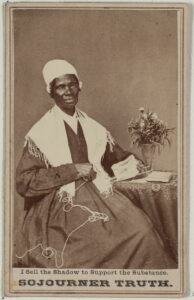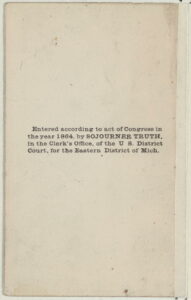The following is a guest post by Marilyn Creswell, 2020 Librarian-in-Residence for the U.S. Copyright Office.

This carte de visite of Sojourner Truth shows the copyright notice on its backside. Library of Congress, hdl.loc.gov/loc.rbc/lprbscsm.scsm0880
Sojourner Truth was a preacher, abolitionist, and suffragist. A lesser known fact is that she was also a copyright innovator.
Truth was born in New York around 1797. Enslaved during her youth and early adulthood, she eventually gained freedom and became an important advocate for abolition and women’s rights. By 1863, she was living in Battle Creek, Michigan, and raising money to support the first Michigan Colored Infantry fighting in the Civil War. One of the ways she fundraised was by selling cartes de visite at her lectures and through the mail. Cartes de visite, or calling cards, were pocket-sized photographs often mounted on cardboard. They reached the height of their popularity in the 1860s, and Truth sat for portraits at least eleven times. She would charge twenty-five to fifty cents each. In 1864, her approach to her cartes de visite changed: she registered her copyright claims in them.
According to one court record, Truth deposited “the title of an Engraving, the title whereof is in the words, towit: [Picture of Sojourner Truth] ‘I sell the Shadow to Support the Substance, Sojourner Truth.’” That copyright entered the public record on February 16, 1864.

Reverse side of Sojourner Truth’s carte de visite, including the copyright notice. Library of Congress, hdl.loc.gov/loc.rbc/lprbscsm.scsm0880
The evolution of copyright law created the opportunity for Truth’s registered copyrights. The Copyright Act of 1790 had given copyright protection to maps, charts, and books. In 1802, Congress enacted a law that people “who shall invent and design, engrave, etch or work, or from his own works and inventions, shall cause to be designed and engraved, etched or worked, any historical or other print or prints, shall have the sole right and liberty of printing, re-printing, publishing and vending such print or prints, for the term of fourteen years from the recording the title thereof in the clerk’s office, as prescribed by law for maps, charts, book or books[.]”
Truth’s creativity is recorded in history. Registering her cartes de visite as engravings helped Truth make a living and donate generously while she was ill. She officially owned the copyright of her image in her etchings. She reflected that she “used to be sold for other people’s benefit, but now she sold herself for her own.”
All of Truth’s cartes de visite are now in the public domain. Images of Truth’s photographs and their copyright stamps can be found in the Library of Congress’s Rare Book and Special Collections Division and in its Prints and Photographs Division. Digital scans of her cartes de visite are also available in the Library’s online catalog.
Sources
- Editors of Encyclopaedia Britannica. “Carte-de-visite.” Encyclopaedia Britannica, Encyclopedia Britannica, Inc., last modified June 10, 2016, https://www.britannica.com/technology/carte-de-visite.
- Grigsby, Darcy Grimaldo. Enduring Truths: Sojourner’s Shadows and Substance. Chicago: The University of Chicago Press, 2015.
- “Michigan Copyrights,” Michigan History Magazine XII, no. 1 (1928):121.
- Truth, Sojourner. The Narrative of Sojourner Truth. Boston: The Author, 1850.
